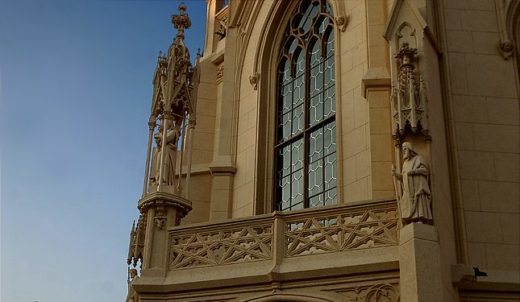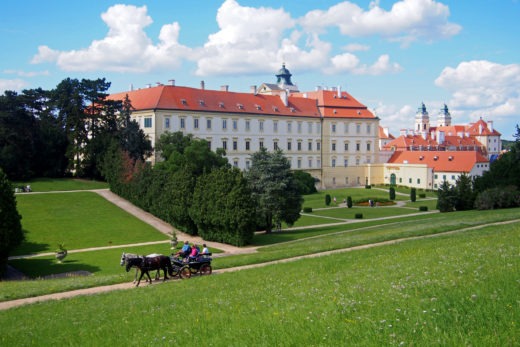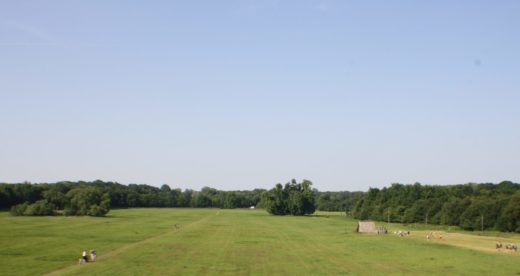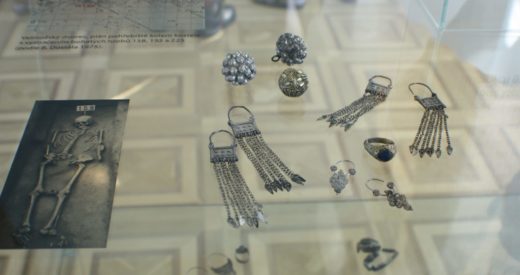There are many beautiful places in the Czech Republic, but one can’t simply visit them all. Unless visiting interesting places is your job – then you may have the time to do so. It’s a shame but I think I might have a solution to your problem. Near the Austrian and Slovak border, there is an area where you can find some of the most beautiful châteaus in this country, practically pristine nature and a lot of history stretching all the way back to the Moravian Empire. By the way, this whole area is on the UNESCO World Heritage List.
Lednice
Let’s start with Lednice. Lednice is a small town that lies in South Moravia – just 7 kilometers northwest of Břeclav and 12 kilometers east of Mikulov – and it’s one of the two centers of the Lednice-Valtice cultural landscape (you can guess which the other one is). Just like most towns and villages in South Moravia, it is among the places where you can taste some of the best wines in the country.
The first time Lednice was ever mentioned in written sources was in 1222 under its Latinized name “Izgruobi”. Back then the town was owned by the Sirotek family, but by the 14th century, most of Lednice was already in the Liechtenstein family’s hands. The Liechtenstein family owned the town for about 700 years and it was them, who essentially sculpted the town.
Thanks to the Liechtenstein family, Lednice has a lot to offer so it comes as no surprise that it is one of the most visited places in the Czech Republic. The particularly popular tourist spot is Lednice Château and its enchanting garden.
The château was originally built as a Gothic fortress, but in the 16th century it was rebuilt as a Renaissance château with a garden. As the Liechtenstein family always followed the newest trends of the time the château was rebuilt again at the end of the 17th century by a famous architect Johann Bernhard Fischer von Erlach. Later it was rebuilt again a couple of times and it was in the 19th century when the château got its final neo-Gothic look. It’s difficult to say what the most fascinating thing about the château is. It could be its overall architecture, chambers, wooden staircase carved out a single tree trunk, or the beautiful greenhouse. There is also a museum of puppets and a grotta (a Baroque cave). No carriers of diseases (aka bats) in the grotta, by the way – it’s as artificial as my elementary school classmates.
But if you like to spend your time outside, you might prefer the garden. Well, garden… There is the English garden and the French park – both different but both equally fascinating. Though, if you prefer taking long strolls in nature over observing colorful flowers, you’ll probably enjoy the French park. It’s basically like a forest full of lakes and small architectural structures, which include a Minaret built by Josef Hardmuth.
By the way, I also recommend you take a stroll around the town – it’s a beautiful place and there are many other interesting things to see – for example, the square!

Valtice
Lednice’s “twin town” is Valtice and it’s equally beautiful. Sure, Valtice Château doesn’t have a big park with lakes like Lednice (though it does have a park, it’s just smaller), but that doesn’t make the town any less interesting. In fact, the Baroque château is considered one of the most impressive châteaus in Central Europe. It was originally built as a Gothic fortress just like the Lednice Château but considering that it was owned by the Liechtenstein family, it should be no surprise that it was also rebuilt a couple of times. By the way, it’s the architect Johann Bernhard Fischer von Erlach who is responsible for its final Baroque form.
The whole town of Valtice is interesting – you can, for example, explore the local square which is full of impressive buildings, small architectural structures, cafés and restaurants. Besides the square, you can also take a look at the local Neo-Renaissance town hall, Church of the Assumption of the Virgin Mary, Marian column and the Convent of St. Augustine. No wonder that a lot of scenes from the short TV series about Maria Theresa were filmed there! Not to mention that it is one of the most popular wine towns in the Czech Republic! If you’re not a fan of wine, you can, however, visit some of the local cafés!

John’s Castle
Lednice and Valtice are not the only interesting places in the area. Located near Lednice, there is John’s Castle (Janův hrad or Janohrad in Czech, Johann(e)sburg or Hansenburg in German). It’s actually not a castle but an artificial castle ruin and since it’s just an artificial ruin, it’s open to the public and completely safe for visiting. Just like the Minaret in Lednice it was built by Josef Hardmuth in the 19th century. You know, a typical romantic era…
You can get there by foot (I tried to do that once in summer and it was a bad idea) or by bicycle from Břeclav or by boat from Lednice. Traveling there by boat is actually something I can recommend because that way you’ll also get to see a part of the area called “Moravian Amazonia”.
Pohansko
If you’re a fan of early medieval European history or a (neo)pagan, you’ll definitely enjoy visiting Pohansko – a large Great Moravian fortified settlement situated in the forests near the town of Břeclav. It was built in the 9th century and it was one of the most important settlements in the whole Moravian Empire at the time. In fact, Pohansko is nowadays one of the most important early-medieval archaeological sites in the whole of Central Europe.
It is also assumed that it was the military center of the empire due to its extensive fortification. Sometime after the fall of the Moravian Empire in the 10th century, Pohansko was abandoned for unknown reasons. Historians, archaeologists, and other experts, however, think that this was caused by adverse climatic changes and the aftermath of constant wars with Hungarians (who probably also caused the fall of the whole empire).
An interesting thing is that ruins of two churches were found in Pohansko which was rather unusual for such settlements. Historians and archaeologists offer a possible explanation: During the Christianization of the Moravian Empire, a church was raised in the place of a pagan shrine. Not all pagans, however, abandoned their old religion for Christianity – despite the possibility of getting killed – and so they decided to take their sacred place back and burned down the church. The Christians then rebuilt it. And the pagans burned it down again. Eventually, the Christians got tired of this, left the place to the pagans, and built a new church elsewhere. Speaking of pagans, the name “Pohansko” actually means “a pagan place”, though it’s not the settlement’s original name – that one remains unknown.

As incredible as it sounds, what historians and archaeologists say about Pohansko is similar to an old legend about the place. Unfortunately, I don’t remember the details and can’t find it anywhere on the internet (it’s in the book that I left in Břeclav at my family’s house, damn it!), so just in a nutshell: When the priests Constantin and Methodius brought Christianity to the Moravian Empire, they visited Pohansko as well. But the locals refused to accept the new religion and so god damned the place – it disappeared from the Earth’s surface together with its inhabitants.
But Pohansko isn’t just an early-medieval settlement and a great place for strolls and picnics – there is also a beautiful Empire château situated there. It was built in the 19th century by Josef Hardtmuth and Josef Kornhäusel for the Liechtenstein family. Nowadays there is an exposition dedicated to the place’s pagan history, so make sure to “Czech” that out (ok, I’ll show myself out now).
If you like neither pagans nor cute châteaus, you might like to visit the nearby light fortifications from 1936–1938. Some of them are renovated and accessible to the public.

Other beautiful places in the area
Ok, so I covered Lednice, Valtice, John’s Castle, Moravian Amazonia, and Pohansko. But we’re still not at the end of the list.
When traveling from Lednice to John’s Castle, you can find another château – a tiny classical hunters’ château built in the 19th century by Josef Hardtmuth for the Liechtenstein family. How many times have I already used this sentence, by the way?
Josef Hardtmuth also built the Empire château Belvedér near Valtice and Rendezvous (Diana’s Shrine).
Other buildings worth visiting are the Rajstna Colonnade and the Saint Hubert’s Chapel. These buildings weren’t, however, built by Josef Hardtmuth – quite surprisingly at this point.
You can also visit Hraniční zámeček – a classical château located between Lednice and Hlohovec. It looks a bit like the one in Pohansko, except there is a restaurant and a winery situated there. If you still have enough time and energy, don’t forget to visit also the Tři grácie (Temple of the Three Graces) and Rybniční zámeček (Jägerhaus, Jagdschloß am Teiche or Teichsalett in German).
As you can see, the Lednice-Valtice cultural landscape is full of amazing places and historical monuments. So it’s up to you to explore the place. And you’d better book a hotel because you can’t manage to visit all of these places in one day.
But if you’re a curious person and like traveling, keep an eye on our blog to learn more about these interesting places! If you don’t want to check the blog for more tips for trips, just subscribe to our special newsletter or follow us on Facebook and Instagram!
